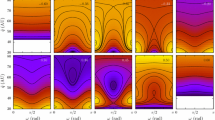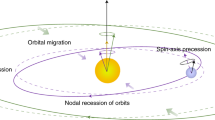Abstract
We present here a very simple model that could explain the relatively high eccentricities and inclinations observed in the minor planet belt. This model is based upon the sweeping of the secular resonances ν6 and ν16 through the belt due to the gravitational effect of the dissipation of a primitive solar nebula. The sweeping of the ν16 secular resonance (responsible for the high inclinations) is very sensitive to the density profile of the nebula. For the model to work we need a density profile proportional to ϱ−k with κ between 1.0 and 1.5.
Similar content being viewed by others
References
Bretagnon, P.: 1974, “Termes à longues périodes dans le système solaire.” Astron. Astroph., 30, 141–154.
Henrard, J. and Lemaitre, A.: 1983a, “A Second Fundamental Model of resonance.” Celest. Mech., 30, 197–218.
Henrard, J. and Lemaitre, A.: 1983b, “A Mechanism of Formation for the Kirkwood gaps.” Icarus, 55, 482–494.
Heppenheimer T.A.: 1980, “Secular resonances and the origin of eccentricities of Mars and the Asteroids.” Icarus, 41, 76–88.
Hunter, C.: 1965, “Oscillations of self-graviting disks.” Month. Not. R. Astron. Soc., 129, 321–343.
Lass H. and Blitzer L.: 1983, “The gravitational Potential due to uniform disks and rings.” Celest. Mech., 30, 225–228.
Lemaitre A.: 1984, “The formation of the Kirkwood gaps in the Asteroid Belt.” Celest. Mech., 34, 329–341.
Nobili, A. M., Milani, A. and Carpino, M.: 1989, “Fundamental frequencies and small divisors in the orbits of the outer planets.” Astron. Astrophys., 210, 313–336.
Scholl, H., Froeschle, Ch., Kinoshita, H., Yoshikawa, M. and Williams, J.G.: 1989, “Secular resonances.” Asteroids II, Eds. Binzel R.P., Gehrels T. and Matthews M.S., University of Arizona Press,845–861.
Torbett, M., Greenberg, R. and Smoluchowski, R.: 1982, “Orbital Resonances and Planetary Formation Sites.” Icarus, 49, 313–326.
Ward W.R.: 1981, “Solar nebula Dispersal and the Stability of the Planetary Syatem.l” Icarus, 47, 234–264.
Weidenschilling, S. J.: 1977, “The distribution of mass in the planetary system and solar nebula.” Astrophysics and Space Sciences, 51, 153–158.
Williams, J.G.: 1969, Ph.D. dissertation University of California, Los Angeles.
Yoshikawa, M.: 1987, “A simple analytical model for the secular resonance ν6 in the asteroidal belt.” Celest. Mech., 40, 233–272.




